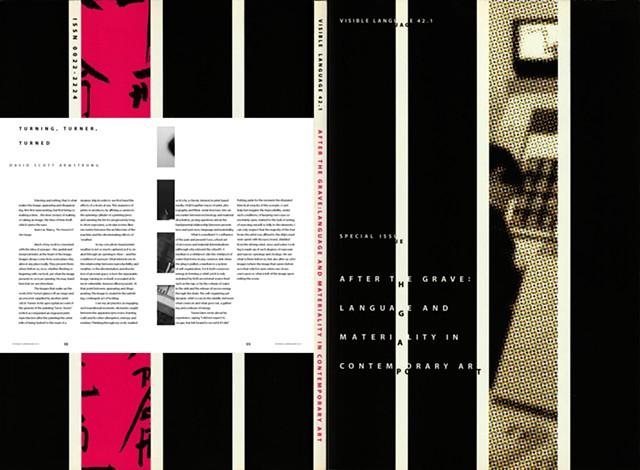Writing
published in:
After the Grave: Language and Materiality in Contemporary Art
Visible Language
issue 42.1, 2008, Rhode Island School of Design.
(co-edited by David Scott Armstrong and Patrick Mahon).
“Entering and exiting, that is what makes the image: appearing and disappearing. Not first representing, but first being or making a time…the time [temps] of making or taking an image, the time of time itself, which opens the eyes ”
- Jean-Luc Nancy, The Ground of the Image
Much of my work is concerned with the idea of passage — the spatial and temporal index at the heart of the image. Images always come from some place else, almost any place really. They present themselves before us, now; whether fleeting or lingering with our look, yet what the image presents to us is an opening. We may stand here but we see elsewhere.
The images that make up the work (After Turner) glance off an image and an anecdote supplied by another artist, J.M.W. Turner. In his apocryphal account of the genesis of the painting “Snow-Storm” (which accompanied an engraved print reproduction after the painting) the artist tells of being “lashed” to the mast of a steamer ship in order to see first hand the effects of a storm at sea. This sequence of prints re-produces, by affixing a camera to the spinning cylinder of a printing press and opening the iris for progressively long to short exposures, a circular (vortex-like) encounter between the architecture of the machine and the disorientating effects of “weather”.
In my own photo based prints weather is not so much captured as it is created through an opening to time — and the condition of exposure. What interests me in this relationship between reproducibility and weather, or the disorientation and dissolution of pictorial space, is how the repeatable image, turning in on itself, is revealed at its most vulnerable, tenuous (illusory) point. At that point between: appearing and disappearing. The image is created in the unfolding, contingent act of looking.
I see my art practice as engaging such transitional moments. Moments caught between the apparatus (processes, framing, craft) and its other (disruption, entropy and residue). Thinking through my work, marked as it is by a chronic interest in print based media, I fold together traces of print, photography, and filmic, serial structure, into an encounter between technology and material dissolution, posing questions about the fundamental relationship between presentness and pastness, language and materiality.
What is a medium? A confluence of the past and present? Less, a fixed set of processes and material determinations (although why reinvent the wheel?). A medium is a whirlpool. Like the whirlpool of water that forms in any common sink when the plug is pulled, a medium is a system of self-organization. For it both conserves energy in forming a “whirl”, yet it is only sustained by both an external source feed such as the tap, or by the volume of water in the sink and the release of excess energy through the drain. The self-organizing yet dynamic whirl occurs in the middle, between what comes in and what goes out, a gathering and a release of energy.
Turner later wrote about his experience, saying, “I did not expect to escape, but felt bound to record it if I did.” Putting aside for the moment the disputed historical veracity of this scenario I can’t help but imagine the impossibility, under such conditions, of keeping one’s eyes so resolutely open, trained to the task of seeing, of exposing oneself so fully to the elements. I can only suspect that the majority of the four hours the artist was affixed to the ship’s mast were spent with his eyes closed, shielded from the driving wind, snow and water. Looking is made up of such degrees of exposure and repose: openings and closings. We see what is there before us, but also after us: after images (where the image that opens before us is that which is seen when one closes one’s eyes) or, what is left of the image upon exiting the scene.
